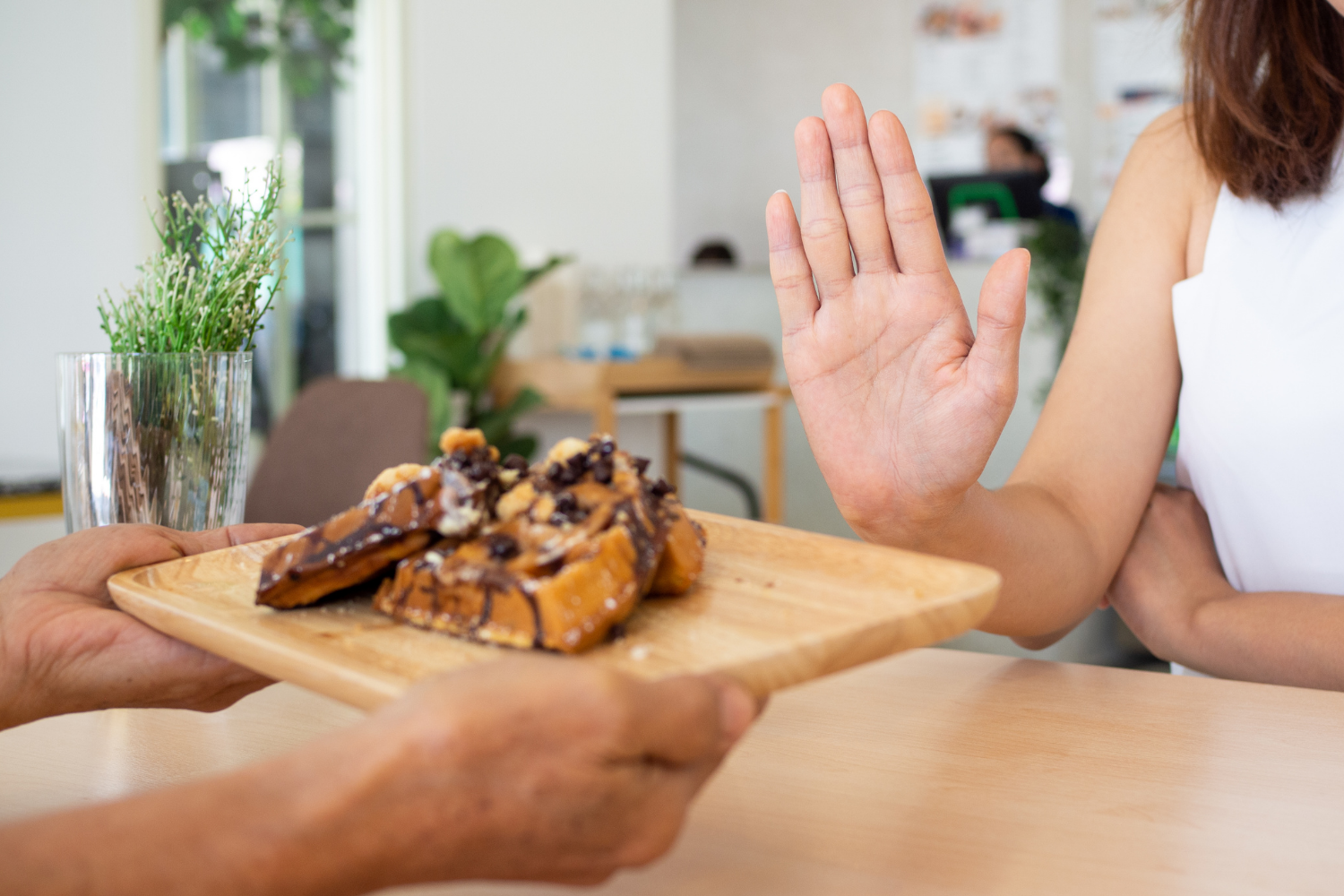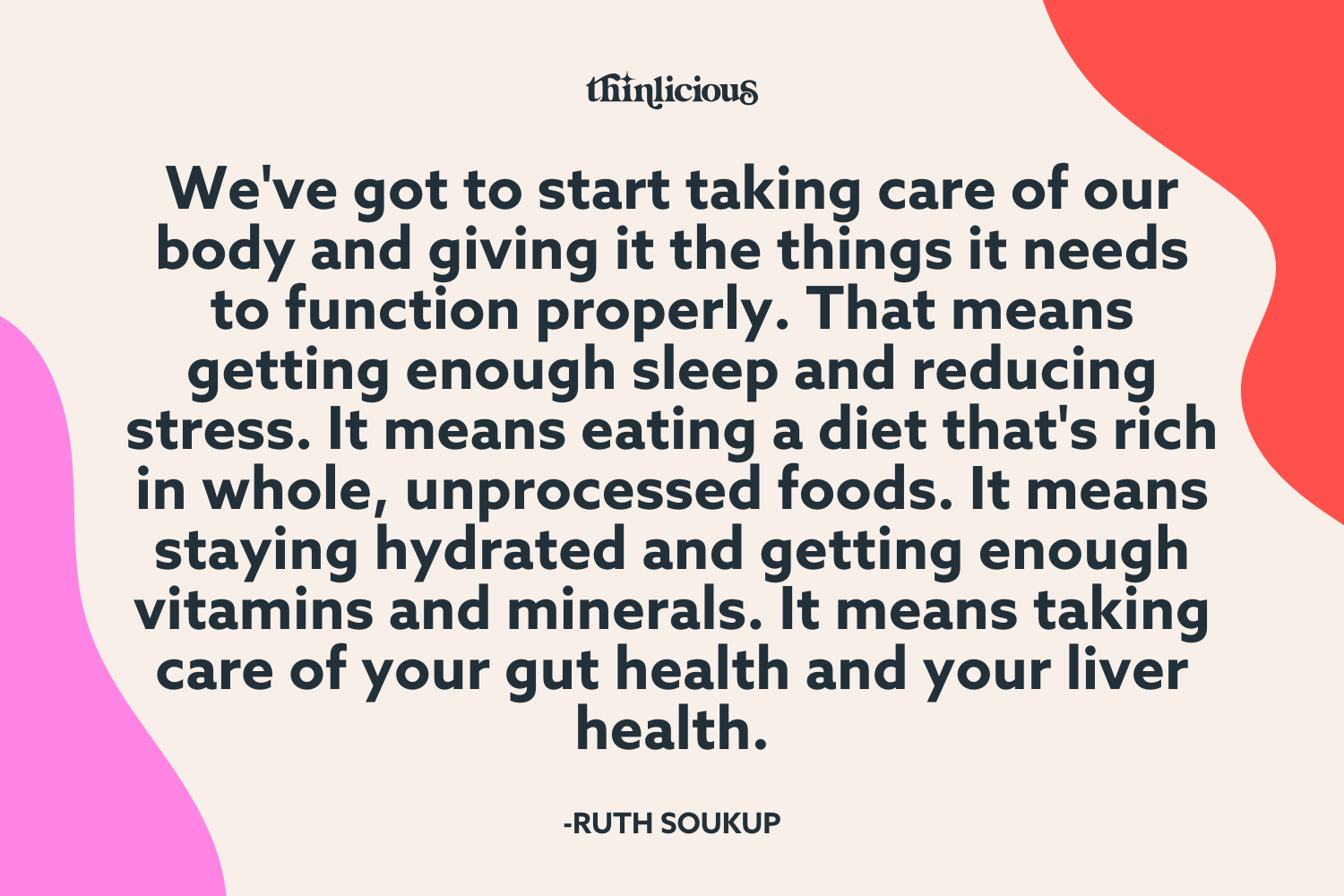You know that feeling when you’re trying to eat healthy and you’re totally crushing it…and then out of nowhere, you’re hit with this irresistible CRAVING for something sweet?
And suddenly, it’s ALL you can think about—that donut you saw in the break room, or the pint of ice cream in your freezer, or the leftover halloween candy you hid from your kids.
Welcome to sugar addiction and—news flash—even if your cravings aren’t for sweet things, but other high carb foods like bread or pasta or potato chips—it still comes down to sugar.
The good news is that there IS a way to break free and retrain your brain, which is why today, we’re going to take a dive deep into the science of sugar addiction, and talk about what’s really going on in your body and your brain when you consume sugar, and how you can use that knowledge to your advantage to actually RESET your brain and get off the sugar rollercoaster for good.
Are you ready to create the ultimate 12-month blueprint for reaching your health & weight loss goals this coming year?

Our free on-demand video training will walk you through how to make 2024 THE year you set health goals…and keep them.
Because maybe you’re like me and you’ve tried to convince yourself that you just have a “sweet tooth,” and that it’s totally normal to have these cravings all the time. And honestly, for a long time, I felt totally HELPLESS to change.
Maybe that’s how you feel right now. Like you try so hard to be good, but you always end up back at square one—craving sugar like crazy and feeling totally out of control.
And while most of us probably understand, at least on some level, that sugar is addictive, I don’t think most of us have really stopped to think about just how devastating and dangerous this addiction really is.
Maybe you’ve heard the stories about lab mice who choose sugar water over cocaine, or you’ve read an article about how sugar addiction is just as bad as heroin addiction. Or maybe you’ve just experienced those intense cravings and wondered why it’s so hard to say no.
But at the same time, it can be hard you wrap your head around the idea that something SO common, something we eat literally every day, could actually be that bad for us.
And so we just keep eating it. And we keep feeding it to our kids.
And we keep getting fatter and sicker and more addicted.

The Harsh Reality of Sugar Addiction
Because the harsh reality is, sugar IS addictive.
But not only that it’s in pretty much EVERYTHING we eat. In fact, the food industry has worked really hard to make sure of it, because they know that the more sugar they put in their products, the more products we’ll buy.
And we’re buying it, alright.
Americans alone consume over 11 million metric tons of added sugar every year. That’s 11 MILLION TONS. Or to put it in perspective, that’s the equivalent of over 2 TRILLION pounds of sugar. Every year. In just the United States.
And in case you’re wondering, that breaks down to about 152 pounds of sugar per person, per year. That’s almost half a pound of sugar every single day.
It’s a CRAZY amount of sugar.
And it’s killing us. And I don’t say that mildly.
Added sugar is quite literally the new tobacco. It’s the new silent killer. It’s the new thing that is slowly, and in most cases almost imperceptibly, destroying our health from the inside out.
And it’s not so new, actually.
A brief history of fructose
It all goes back to a single molecule—something called fructose.
Fructose, as you may or may not know, is the sugar that’s found in fruit. And in small amounts, like what you’d find in a piece of whole fruit, it’s not really a big deal. Your body can handle it just fine. In fact, it actually has a lot of health benefits, because it’s also accompanied by dietary fiber and other nutrients that help your body process it properly.
But in the late 70s and early 80s, the food industry figured out how to start extracting fructose from corn and other sources, and then adding it to pretty much EVERYTHING. And that’s when all hell broke loose.
Because the problem with this “added” fructose is that it’s not bound to anything else. It’s not found in nature. It’s not accompanied by fiber or any other nutrients. It’s just pure, unadulterated sugar. And it’s highly concentrated and highly addictive. In fact, it’s estimated that it’s 10 times more addictive than cocaine.
And we’re consuming it in RECORD amounts. Like I said before, Americans alone are consuming over 11 million metric tons of added sugar every year. And that’s 11 million tons of fructose. Just in the United States.
That’s a LOT of fructose.
It’s not just in sweet stuff, either. It’s added to bread, ketchup, sauces, salad dressings, and pretty much any processed food you can think of. Potato chips. Cereal. Granola bars. Even things like yogurt and sports drinks. And it’s doing some serious damage.
Like I said, it’s literally killing us.
Because fructose is highly toxic to the body. It’s toxic to the liver, to the cardiovascular system, and to the pancreas. And because it’s in pretty much EVERYTHING we eat, it’s slowly wreaking havoc on our bodies and our health.
In fact, it’s what’s behind pretty much every major health problem we face today—obesity, diabetes, high blood pressure, heart disease, stroke, cancer, autoimmune disease, Alzheimer’s, dementia. You name it. Fructose is the underlying cause.
How fructose affects your brain
And if that all sounds a little bit depressing, then buckle up, because we’re unfortunately just getting started. Because the problem with fructose goes even deeper than all of that. Because when we consume it, it actually changes our BRAIN.
That’s right—fructose is a powerful psychoactive substance, meaning it has a direct effect on the central nervous system. In other words, it’s a drug. And it affects our brain in much the same way that drugs like cocaine or heroin do.
It releases a surge of dopamine—that “feel good” neurotransmitter that gives us a sense of pleasure and reward. And that dopamine release is what creates that immediate and almost insatiable craving for MORE.
But it doesn’t stop there. Because the more fructose we consume, the more our brain becomes desensitized to dopamine. And that means we need more and more fructose to get that same high. We need to keep feeding the beast.
And that, my friends, is the definition of addiction. It’s literally a cycle of craving, indulging, and then needing more to get the same effect.
And this is where it’s really important to understand what’s going on in our brain, because the brain is a tricky thing. It’s hard-wired to seek out pleasure and reward, and to avoid pain. And it’s also hard-wired to form habits and create neural pathways that become almost impossible to break.
And that’s why, once we start consuming fructose on a regular basis, it’s so hard to STOP. Because our brain has formed this powerful connection between the pleasure and reward of dopamine, and the consumption of sugar. And those neural pathways become so ingrained that it’s almost like an automatic response. We don’t even think about it. We just do it.
And that’s also why, when you decide that you want to start eating healthier, and you try to cut out the sugar and the carbs, you feel like you’re going CRAZY. Because your brain is literally sending you all of these signals that say “FEED ME SUGAR!” And it’s almost impossible to ignore.
In fact, studies have shown that when people try to cut out sugar, they experience intense cravings and withdrawal symptoms that are very similar to what drug addicts experience when they try to quit. They get irritable and moody. They have headaches. They feel tired and lethargic. They can’t concentrate. They feel depressed.
It’s not fun. And it’s not easy.
How to break free from the sugar addiction cycle
But the good news in all of this is that it IS possible to break free from the sugar cycle. Because while sugar addiction is very real, it’s also something that can be overcome. It might not be easy, but it CAN be done.
And the first step in doing that is really just understanding what’s happening in our body and our brain, and then making a conscious decision to change and take back control. In other words, we need to retrain our brain.
So how do we do that? How do we overcome something as powerful as sugar addiction? Well, it starts with a few simple changes that will have a BIG impact on your brain and your body.
Shift your approach to food
The first thing you need to do is start looking at food as FUEL, not as a source of pleasure or reward. This is a mindset shift that can be really hard, especially if you’ve spent most of your life using food to comfort you or to celebrate or to cope with stress. But it’s a really important one.
Because when we look at food as fuel, it becomes a lot easier to make healthy choices. We start to recognize that sugar and processed carbohydrates don’t actually DO anything for our body. In fact, they do the OPPOSITE. They make us sick, and fat, and addicted. They literally steal our energy and our vitality and our health. They rob us of the ability to live our life to the fullest.
And when you start to see it that way, then all of a sudden that donut just doesn’t look so good anymore. Because it’s not a treat. It’s poison. And you wouldn’t willingly consume poison.
Reduce your sugar intake
The second thing you need to do is actually start reducing your sugar intake in a way that’s sustainable. Now, I realize that might sound a little bit odd, coming from someone who has built a whole program around a lifestyle that is essentially sugar and carb-free.
Because YES, the best way to overcome sugar addiction is to actually ELIMINATE the sugar. It’s to get to a place where your body is no longer dependent on sugar for fuel, and you’re able to switch to burning fat instead. That’s the whole idea behind our program—to get your body adapted to burning fat instead of sugar.
But at the same time, I also recognize that it’s not always realistic to think that you can just completely STOP eating sugar and processed carbs, especially if you’ve spent most of your life addicted to them. It’s just not going to happen. You’re going to get overwhelmed and frustrated, and you’re going to give up.
And that’s not what I want for you. Because even though I’m a big believer in the power of TOTAL transformation, I also know that change is a process, and that it needs to happen at a pace that you’re comfortable with. I know that you have to be READY to change, and that there has to be a certain level of internal motivation for it to actually stick.
So if you’re not quite ready for the big changes, then start small. Start by cutting out the most obvious sources of added sugar from your diet—things like soda, and juice, and candy, and cookies, and cake. The stuff that you KNOW is just loaded with sugar.
And then, once you’ve done that, start looking at the labels of the other foods you eat, and try to find the hidden sources of added sugar. Because I guarantee you they’re there. They’re in your ketchup and your marinara sauce, in your salad dressing and your yogurt. They’re in your protein bars and your granola and your “healthy” smoothies. They’re in your bread and your pasta and your hamburger buns.
And as you start to identify those hidden sources of added sugar, start looking for healthier alternatives. Find a sugar-free ketchup, or a salad dressing that doesn’t have any added sugar. Switch to a yogurt that has no added sweeteners. Buy a bread that’s made with almond flour instead of wheat flour. Make small, sustainable changes that won’t feel overwhelming, but will still have a big impact on your health.
And the more you do that, the easier it will become to make even bigger changes, because your brain will start to form new neural pathways, and your body will start to heal.
Heal your body from the damage you’ve done
And speaking of healing, the third thing you need to do to overcome sugar addiction is to actually HEAL your body from the damage that’s been done. Because a big part of the reason we become addicted to sugar in the first place is because our bodies are so out of whack.
We’re eating a highly processed diet that’s full of sugar and toxins, and that’s causing inflammation and leaky gut and all sorts of other problems. We’re not getting enough sleep, or enough nutrients. We’re stressed out and overworked. All of these things are contributing to our addiction.
And so in order to overcome it, we’ve got to start healing from the inside out. We’ve got to start taking care of our body and giving it the things it needs to function properly. That means getting enough sleep and reducing stress. It means eating a diet that’s rich in whole, unprocessed foods. It means staying hydrated and getting enough vitamins and minerals. It means taking care of your gut health and your liver health.
And it also means being patient, and giving yourself grace. Because healing takes time, and change doesn’t happen overnight. But it DOES happen, if you’re consistent and you keep working at it.

Final Thoughts
Sugar addiction is a real thing, and it’s actually a lot more common than you probably think. But it CAN be overcome, if you’re willing to make the necessary changes and retrain your brain.
The first step in doing that is to start looking at food as fuel, not as a source of pleasure or reward. The second step is to actually start reducing your sugar intake in a way that’s sustainable for you, whether that’s by cutting out the most obvious sources of added sugar, or by making small changes to your diet that will have a big impact. And the third step is to focus on actually HEALING your body from the inside out, by taking care of your gut health and your liver health, as well as making sure you’re getting enough sleep and reducing stress.But if you want more information, be sure to check out our free training video–Healthy, Happy & Free in 2024, especially if you’re serious about transforming your health or reaching your weight loss goals this year. In it, I’ll walk you through creating your own personalized health plan and also explain a little bit more about why so many of the things you’ve tried in the past to get healthy and lose weight haven’t actually worked, and what you can do instead.








